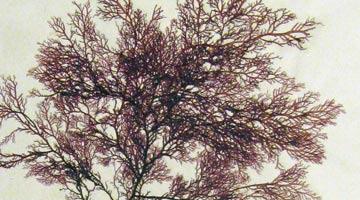
Non-flowering plants
Cryptogamic plants are responsible for 84% of the worlds botanical diversity.
This is part of the Botany collection.
The cryptogamic collections are divided into 5 main areas:
- Algae (including Diatoms)
- Bryophytes (Mosses, Liverworts, Hornworts)
- Ferns and Fern allies
- Fungi (non-lichenised)
- Lichens (Lichenised fungi)
Cryptogamic plants are responsible for 84% of the worlds botanical diversity.
Algae (including diatoms)
The Algal collections at World Museum contains around 15,000 specimens. It is an internationally important collection which holds historical material from the 18th, 19th and 20th centuries and is rich in type material. It is actively expanding its contemporary collections providing a unique and important timeline to the health of our seas.
They contain significant collections from Ross's voyage of the Erebus and Terror (1839-43) to the Southern and Antarctic regions. The Algal collections also have a number of bound volumes such as the Thomas Velley (1748-1806) herbarium which consists of eight volumes of marine algae from the south coast of England, and dates from c1800 and J.R. Hulme's 'The Scarborough Algae' (1842).
Liverpool as a city has a long history of algal research and the collections reflect this local research interest. The herbarium includes the collections of leading phycologists who were based at the University of Liverpool such as Elsie May Burrows (1913-1986), Elsie Conway (1902-1992), Sheila M. Lodge, Mary Winifred Parke (1908-1989), Joanna Jones (1930-2017) and George Russell (1933-2013).
Find out more about some of these collectors
The collections contain the diatom collections of Waddington (1938-1943) which provide a unique baseline to examine climate change for the local area, providing an invaluable time capsule into the biodiversity and environmental status of the area. They contain contemporary collections of Reid (post 2009, pre 2009 at Natural History Museum London) which are rich in material from the Mersey and Dee estuaries and Anglesey. They also include the Liverpool Microscopical Society diatom collection (1868-1988).
Explore some of our British algae collections
Bryophytes (Mosses, Liverworts, Hornworts)
The bryophyte collections have excellent coverage of temperate regions, especially British species. They contain historically important material from the West Indies and the South Pacific.
Fern and fern allies
This collection of around 11,000 specimens consists of ferns and lycophytes (clubmosses, quillworts and spikemosses). They are vascular plants that use spores, rather than seeds, to reproduce. The internationally important fern collection has particular strengths in material from Sri Lanka and S.E. Asia.
The collection is actively expanding its holdings notably with specimens from Eric Greenwood, Michael Hayward and Alison Evans, and will be one of the depositories for the Flora of Honduras project.
The collections also have a collection of Nature Printed Ferns and bound Fern Albums such as Eric Craig’s ‘Ferns of New Zealand’.
The archives of the British Pteridological Society are housed within Botany in the museum..
Fungi (Non-lichenised)
The fungi collections consist mainly of British specimens dating from 1878 to present day. It includes fungi collected by J.F. Royle (1799-1858) from India and the current research collection of G. Greenhalgh containing bark and wood inhabiting Ascomycetes (Pyrenomycetes and Loculoascomycetes).
Lichens (Lichenised fungi)
The lichen collections offer extensive collections from the North West England, the Isle of Man and North Wales. The collections have international coverage with many early examples from global exploration including specimens from the Higgins' Voyage of the Argo (1876). The collections contain specimens collected by James Edward Smith (1759-1828).
